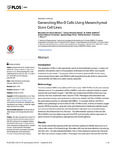Mostrar o rexistro simple do ítem
Generating Rho-0 cells using mesenchymal stem cell lines
| dc.contributor.author | Fernández-Moreno, Mercedes | |
| dc.contributor.author | Hermida Gómez, Tamara | |
| dc.contributor.author | Gallardo, M. Esther | |
| dc.contributor.author | Dalmao-Fernández, Andrea | |
| dc.contributor.author | Rego-Pérez, Ignacio | |
| dc.contributor.author | Garesse, Rafael | |
| dc.contributor.author | Blanco García, Francisco J | |
| dc.date.accessioned | 2020-03-24T11:11:17Z | |
| dc.date.available | 2020-03-24T11:11:17Z | |
| dc.date.issued | 2016-10-20 | |
| dc.identifier.citation | Fernández-Moreno M, Hermida-Gómez T, Gallardo ME, Dalmao-Fernández A, Rego-Përez I, Garesse R, et al. Generating Rho-0 cells using mesenchymal stem cell lines. PLoS One, 2016;11(10): e0164199 | es_ES |
| dc.identifier.issn | 1932-6203 | |
| dc.identifier.uri | http://hdl.handle.net/2183/25231 | |
| dc.description.abstract | [Abstract] Introduction, The generation of Rho-0 cells requires the use of an immortalization process, or tumor cell selection, followed by culture in the presence of ethidium bromide (EtBr), incurring the drawbacks its use entails. The purpose of this work was to generate Rho-0 cells using human mesenchymal stem cells (hMSCs) with reagents having the ability to remove mitochondrial DNA (mtDNA) more safely than by using EtBr. Methodology. Two immortalized hMSC lines (3a6 and KP) were used; 143B.TK-Rho-0 cells were used as reference control. For generation of Rho-0 hMSCs, cells were cultured in medium supplemented with each tested reagent. Total DNA was isolated and mtDNA content was measured by real-time polymerase chain reaction (PCR). Phenotypic characterization and gene expression assays were performed to determine whether 3a6 Rho-0 hMSCs maintain the same stem properties as untreated 3a6 hMSCs. To evaluate whether 3a6 Rho-0 hMSCs had a phenotype similar to that of 143B.TK-Rho-0 cells, in terms of reactive oxygen species (ROS) production, apoptotic levels and mitochondrial membrane potential (Δψm) were measured by flow cytometry and mitochondrial respiration was evaluated using a SeaHorse XFp Extracellular Flux Analyzer. The differentiation capacity of 3a6 and 3a6 Rho-0 hMSCs was evaluated using real-time PCR, comparing the relative expression of genes involved in osteogenesis, adipogenesis and chondrogenesis. Results. The results showed the capacity of the 3a6 cell line to deplete its mtDNA and to survive in culture with uridine. Of all tested drugs, Stavudine (dt4) was the most effective in producing 3a6-Rho cells. The data indicate that hMSC Rho-0 cells continue to express the characteristic MSC cell surface receptor pattern. Phenotypic characterization showed that 3a6 Rho-0 cells resembled 143B.TK-Rho-0 cells, indicating that hMSC Rho-0 cells are Rho-0 cells. While the adipogenic capability was higher in 3a6 Rho-0 cells than in 3a6 cells, the osteogenic and chondrogenic capacities were lower. Conclusion, Among the drugs and conditions tested, the use of d4t was the best option for producing Rho-0 cells from hMSCs. Rho-0 cells are useful for studying the role of mitochondria in hMSC differentiation. | es_ES |
| dc.description.sponsorship | Instituto de Salud Carlos III; CIBERCB06/01/0040 | es_ES |
| dc.description.sponsorship | Instituto de Salud Carlos III; PI 12/329 | es_ES |
| dc.description.sponsorship | Instituto de Salud Carlos III; PI14/01254 | es_ES |
| dc.language.iso | eng | es_ES |
| dc.publisher | PLoS | es_ES |
| dc.relation.uri | https://doi.org/10.1371/journal.pone.0164199 | es_ES |
| dc.rights | Atribución 3.0 España | es_ES |
| dc.rights.uri | http://creativecommons.org/licenses/by/3.0/es/ | * |
| dc.subject | Apoptosis | es_ES |
| dc.subject | Cell differentiation | es_ES |
| dc.subject | Cell line | es_ES |
| dc.subject | DNA | es_ES |
| dc.subject | Flow cytometry | es_ES |
| dc.subject | Membrane potential | es_ES |
| dc.subject | Mesenchymal stem cells | es_ES |
| dc.subject | Phenotype | es_ES |
| dc.subject | Reactive oxygen species | es_ES |
| dc.subject | Real-time polymerase chain reaction | es_ES |
| dc.subject | Mitochondrial | |
| dc.title | Generating Rho-0 cells using mesenchymal stem cell lines | es_ES |
| dc.type | info:eu-repo/semantics/article | es_ES |
| dc.rights.access | info:eu-repo/semantics/openAccess | es_ES |
| UDC.journalTitle | PLoS One | es_ES |
| UDC.volume | 11 | es_ES |
| UDC.issue | 10 | es_ES |
| UDC.startPage | e0164199 | es_ES |
Ficheiros no ítem
Este ítem aparece na(s) seguinte(s) colección(s)
-
INIBIC- REUMA - Artigos [182]






